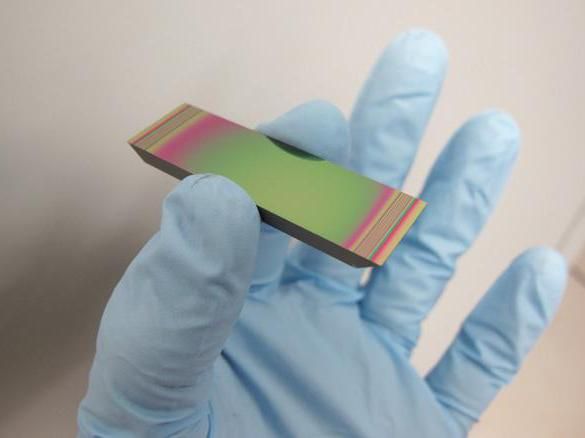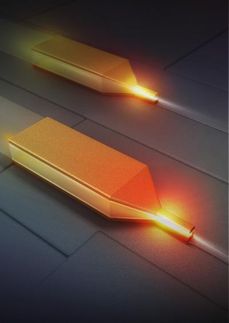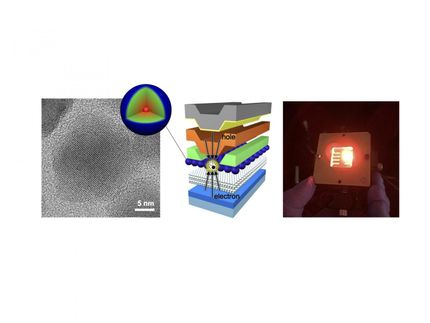New non-mechanical laser steering technology
Advertisement
Scientists at the U.S. Naval Research Laboratory have recently demonstrated a new nonmechanical chip-based beam steering technology that offers an alternative to costly, cumbersome and often unreliable and inefficient mechanical gimbal-style laser scanners.

To date, beam steering has typically relied on mechanical devices, such as gimbal-mounted mirrors or rotating Risley prisms, which have inherent issues, including large size, weight, and power (SWaP) requirements, slow scan rates, high repair and replacement costs, and short lifetimes before mechanical failure. Steerable electro-evanescent optical refractor (SEEOR) chips take laser light in the mid-wavelength infrared (MWIR) as an input and steers the beam at the output in two dimensions without the need for mechanical devices. SEEORs are meant to replace traditional mechanical beam steerers with much smaller, lighter, faster devices that use miniscule amounts of electrical power and have long lifetimes because they have no moving parts.
Jason Myers/U.S. Naval Research Laboratory
The chip, known as a steerable electro-evanescent optical refractor, or SEEOR, takes laser light in the mid-wavelength infrared (MWIR) as an input and steers the beam in two dimensions at the output without the need for mechanical devices -- demonstrating improved steering capability and higher scan speed rates than conventional methods.
"Given the low size, weight and power consumption and continuous steering capability, this technology represents a promising path forward for MWIR beam-steering technologies," said Jesse Frantz, research physicist, NRL Optical Sciences Division. "Mapping in the MWIR spectral range demonstrates useful potential in a variety of applications, such as chemical sensing and monitoring emissions from waste sites, refineries, and other industrial facilities."
The SEEOR is based on an optical waveguide - a structure that confines light in a set of thin layers with a total thickness of less than a tenth that of a human hair. Laser light enters through one facet and moves into the core of the waveguide. Once in the waveguide, a portion of the light is located in a liquid crystal (LC) layer on top of the core. A voltage applied to the LC through a series of patterned electrodes changes the refractive index (in effect, the speed of light within the material), in portions of the waveguide, making the waveguide act as a variable prism. Careful design of the waveguides and electrodes allow this refractive index change to be translated to high speed and continuous steering in two dimensions.
SEEORs were originally developed to manipulate shortwave infrared (SWIR) light - the same part of the spectrum used for telecommunications - and have found applications in guidance systems for self-driving cars.
"Making a SEEOR that works in the MWIR was a major challenge," Frantz said. "Most common optical materials do not transmit MWIR light or are incompatible with the waveguide architecture, so developing these devices required a tour de force of materials engineering."
To accomplish this, the NRL researchers designed new waveguide structures and LCs that are transparent in the MWIR, new ways to pattern these materials, and new ways to induce alignment in the LCs without absorbing too much light. This development combined efforts across multiple NRL divisions including the Optical Sciences Division for MWIR materials, waveguide design and fabrication, and the Center for Bio/Molecular Science and Engineering for synthetic chemistry and liquid crystal technology.
The resulting SEEORs were able to steer MWIR light through an angular range of 14°×0.6°. The researchers are now working on ways to increase this angular range and to extend the portion of the optical spectrum where SEEORs work even further.
Original publication
Jesse A. Frantz, Jason D. Myers, Robel Y. Bekele, Christopher M. Spillmann, Jawad Naciri, Jakub Kolacz, Henry G. Gotjen, Vinh Q. Nguyen, Collin C. McClain, L. Brandon Shaw, and Jasbinder S. Sanghera; "Chip-based nonmechanical beam steerer in the midwave infrared"; Journal of the Optical Society of America B; 2018
Other news from the department science
Most read news
More news from our other portals
See the theme worlds for related content
Topic world Sensor technology
Sensor technology has revolutionized the chemical industry by providing accurate, timely and reliable data across a wide range of processes. From monitoring critical parameters in production lines to early detection of potential malfunctions or hazards, sensors are the silent sentinels that ensure quality, efficiency and safety.

Topic world Sensor technology
Sensor technology has revolutionized the chemical industry by providing accurate, timely and reliable data across a wide range of processes. From monitoring critical parameters in production lines to early detection of potential malfunctions or hazards, sensors are the silent sentinels that ensure quality, efficiency and safety.





























































